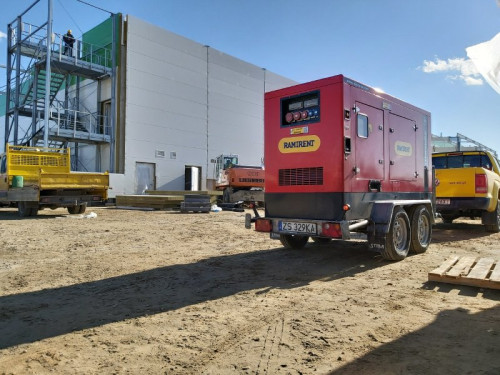The 5 most popular uses for generators
Zastosowania wszystkich agregatów prądotwórczych – przenośnych i stacjonarnych, o dużej i małej mocy – dzielą się na dwie podstawowe grupy: zasilanie urządzeń elektrycznych w miejscach pozbawionych dostępu do sieci elektrycznej oraz zabezpieczanie zasilania awaryjnego w miejscach, w których przerwa w dostawie prądu może mieć poważne konsekwencje ekonomiczne lub stwarza zagrożenie dla zdrowia i życia ludzi.5 sytuacji, w których niezbędne będzie użycie agregatu prądotwórczego

The level of power generated and the mobility (or lack thereof) determine the applicability of generators. Generators available on the market can be divided into portable generators (with the smallest power, usually in the range of about 1.5-15 kVA), mobile generators (medium-power generators equipped with their own wheels or mounted on trailers), stationary generators (compact, installed in special containers devices of medium and high power, such as 500 kVA generators).
Here are five situations in which the use of a generator is essential:
- securing the electricity needs of single-family and vacation homes - a portable 11-15 kVA unit is an excellent solution to the problem of access to electricity in a vacation home or emergency protection in a single-family home,
- protection of surges in energy consumption - if we anticipate the possibility of sudden, periodic increases in demand for electricity (for example, during periods of high temperatures when air conditioning equipment is used intensively), with the use of a generator set we can provide protection against shortages of power supplied to our own home, office or business premises,
- Construction and installation work in the field - generators provide the ability to use power tools and electric-powered machinery and equipment in field conditions where there is no possibility of connecting to the power grid and the use of battery-powered tools is insufficient or economically unjustified - in most cases, portable gasoline generators such as the Atlas Copco three-phase generator will suffice for this purpose,
- organization of outdoor events - generators allow you to organize concerts, festivals, theatrical performances, sports games, but also special events for family and friends in any place, away from urban centers, in virgin areas without access to the power grid - generators allow you to power lighting, sound equipment or multimedia,
- emergency power source - it is necessary in places where even a short-term interruption in energy supply can lead to a threat to the safety of human health and life (hospitals, treatment and diagnostic rooms, elevators, urban transport), losses in breeding and food processing (emergency power supply for poultry farms and fur farms, milking parlors, dairies, slaughterhouses, food production facilities), losses in industry (costs of stopping the operation of production and processing lines and transmission facilities), losses and security risks resulting from data loss (server failures paralyze the operation of any services provided via the Internet).
How to correctly select and properly use a generator set?
The most important criterion in the selection of a generator set is to make a simple addition: we add up the power of all the devices to be powered and compare it with the nominal power of the unit. Ideally, the sum of the power of the devices should be no more than 50% of the power of the unit. Such a large reserve is due to the fact that many appliances (especially those equipped with induction motors) at the moment of start-up have a stepped-up power consumption, which stabilizes within a few seconds after start-up. This phenomenon is offset by the so-called soft start - a technology with which most power tools are equipped, but it is not the rule in all electrical appliances. If we do not take into account the correction of this starting "hill", i.e. the demand for starting power, we may not be able to use all the necessary equipment at the same time.
The next step is to choose a 1-phase or 3-phase (230 V and 400 V) device. 1-phase generators, are usually low-power devices, designed to power power tools or for use in single-family homes as a backup in case of power grid failure. A universal solution is a genset that has both single-phase and three-phase power outlets, such as 7.5-10 kVA gensets.
The fuel used to power the generators is also not insignificant. Smaller models can be powered by gasoline or gas, while large generators are powered by diesel engines. When choosing a specific genset model, it is a good idea to accurately estimate your needs, that is, to do a simulation for a typical emergency. It is necessary to determine what power we will need during a power outage lasting, for example, an hour. Then we need to check the nominal fuel consumption of the genset we own. Compiling the data will allow us to choose a genset with a sufficiently large tank and secure a supply of fuel in case of a power outage.